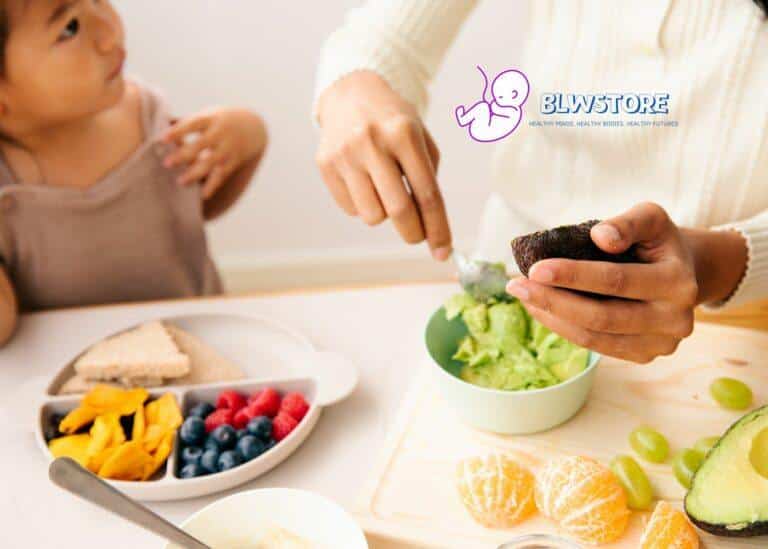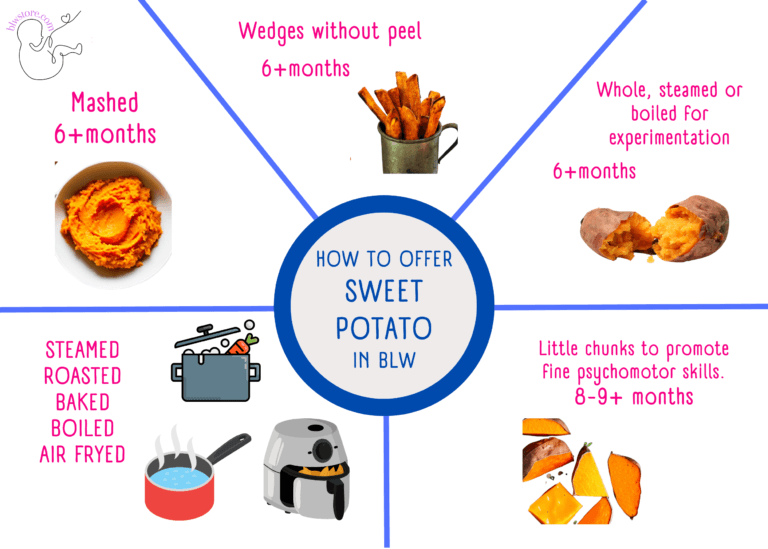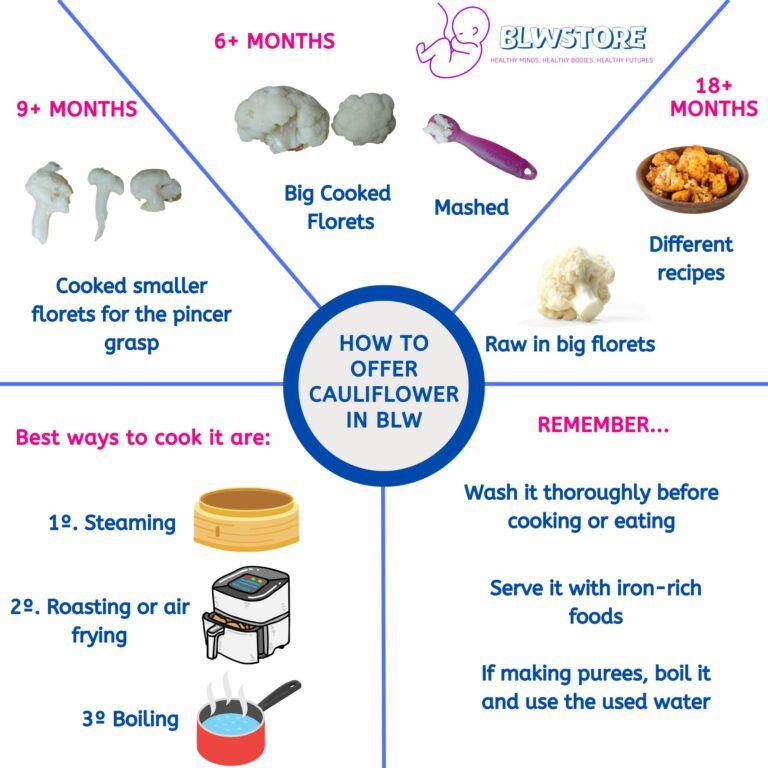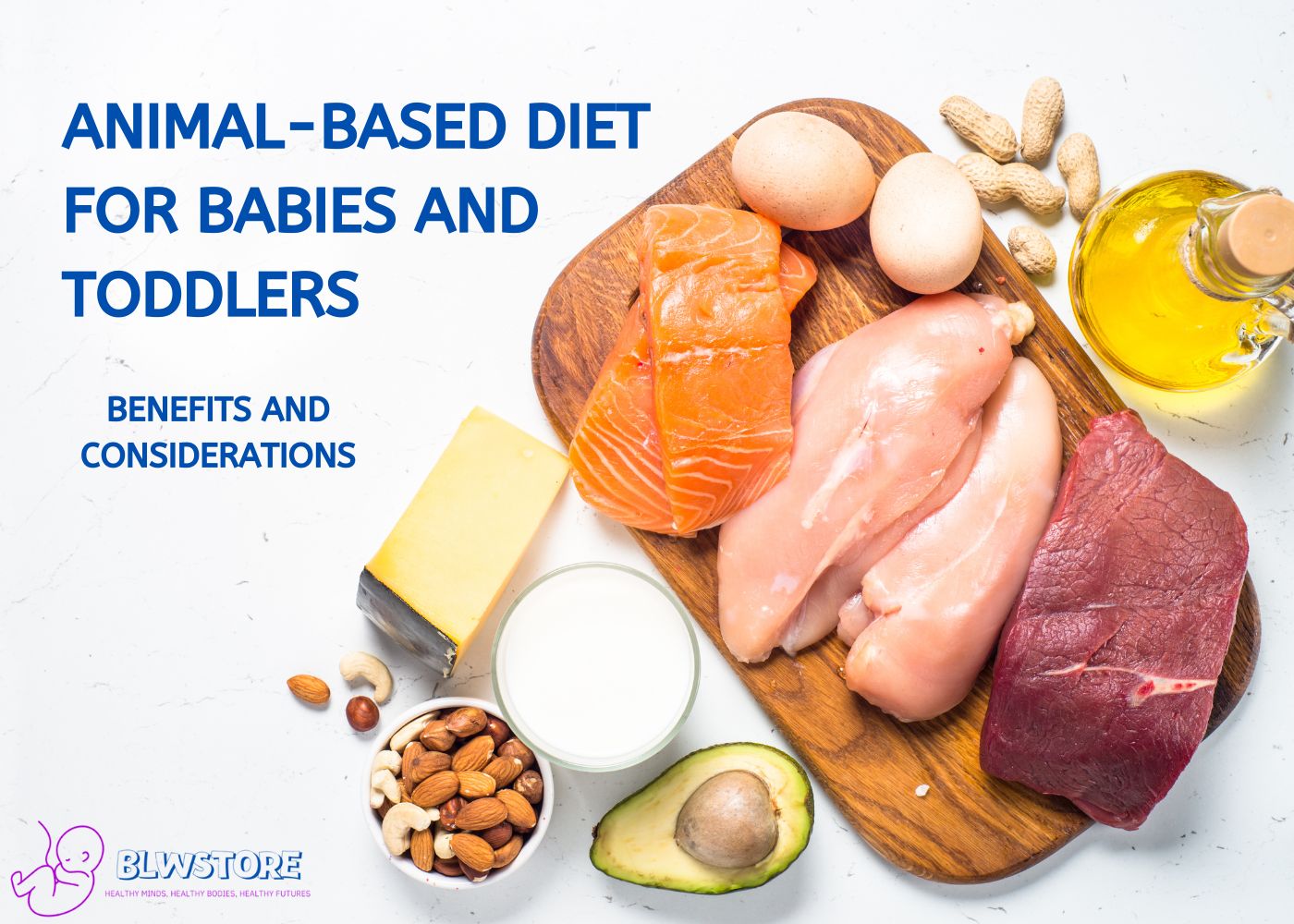
Bioavailability.
That word is one of the most important words when it comes to nutrition and health.
If you don’t know what it means, this is our definition: bioavailability is a term to measure how good our body is to absorb and use the vitamins and minerals in a specific food.
Animal-based foods have, on average, a much higher bioavailability than plant-based foods.
That is precisely why we should feed our children an animal-based diet instead of plant-based. But be careful, “animal-based” does not mean “meat and organs only”; fruits, dairy, and some grains are included in the mix.
Ensuring babies and toddlers get enough of necessary nutrients such as protein, iron, and Vitamin B12, often abundant in animal-based foods, is crucial.
“Helping your child embrace an animal-based diet can pave the way for them to devour a balanced, nutrient-rich diet in the future.”
In this article, we’ll guide you through how to offer your babies and toddlers an animal-based diet. From the benefits and importance to simple, delightful food ideas they will love, we’ve got you covered.
What is an Animal-Based diet?

You might wonder, doesn’t an animal-based diet only involve meats and organs?
That’s a common misconception.
An animal-based diet for your little ones must also include fruits and dairy.
This simply means that in an animal-based diet, foods that come directly from animals take center stage due to their high bioavailability – that is, the nutrients they provide are more readily absorbed by the body.
Animal-derived foods are also tremendously nutrient-rich, making them indispensable for your baby’s and toddler’s development.
An animal-based diet does not mean excluding other food groups. Instead, it is a prioritization strategy, ensuring your youngster gets easily absorbable, nutrient-dense food.
Fruits, for instance, are still an excellent source of essential vitamins and fiber, and they offer a variety of tastes and textures that can help diversify your baby’s palate.
Dairy, on the other hand, provides precious calcium and vitamin D, crucial for bone health. Plus, it’s a convenient source of high-quality protein for kids.
So, while the animal-based foods – such as meats and culinary organs – are the gladiators in the hearty arena of your child’s plate, don’t hesitate to invite fruits and dairy to the feast.
What are the benefits of an animal-based diet for babies and toddlers?
Did you know?
– Iron deficiency affects an estimated 10% of toddlers aged 1-3 years
Thankfully, meat and organs are nature’s multivitamins.
They’re jam-packed with high-quality protein, packed full of essential amino acids that play key roles in growth, brain development, and healthy blood cells. A diet rich in animal-based protein can provide everything your toddler needs to grow and thrive.
But the top-notch protein is only part of the story. Animal-based food sources contain critical nutrients, many of which are only found – or found in substantial quantities – in meat and organ sources.
Here are some of the most vital ones:
- Vitamin B12: This nutrient is vital for brain development and function, and deficiency can lead to serious neurological issues. Animal-based foods are the best natural source of B12.
- Iron: Particularly prevalent in red meat and organs like liver, iron is crucial for creating red blood cells and transporting oxygen throughout the body.
- Creatine: Known mainly for its role in enhancing sports performance, creatine is actually crucial for energy metabolism and brain development. It’s found mostly in meat.
- Docosahexaenoic Acid (DHA): It’s primarily found in fatty fish, although some plant sources contain ALA (alpha-linolenic acid), a precursor to DHA, but the conversion rate in the body is low.
- Taurine: This essential amino acid plays a key role in many bodily functions such as vision, heart function, and immune response. It’s found in high amounts in seafood, meat, and poultry.
- Carnosine: A compound important for muscle function and reducing fatigue during exercise. It is found in animal-based foods.
- Cholesterol: Dietary cholesterol is found only in animal products. It plays a role in the production of hormones and vitamin D.
- Retinol (Active Vitamin A): The form of vitamin A readily used by the body is found only in animal products. Plant-based diets provide beta-carotene, a precursor to vitamin A, but the conversion rate to active vitamin A can be inefficient in some individuals.
Can a child get all the necessary nutrients from an animal-based diet?
Absolutely, your little one can receive all the vital nutrients necessary for growth and development from an animal-based diet.
High-quality animal products such as meat, fish, dairy, and eggs carry a comprehensive range of nutrients including protein, calcium, iron, and essential vitamins and minerals.
These nutrients are central to a child’s physiological development, bolster their immune system, facilitate healthy bone growth, and ensure adequate brain development.
| Basis of Comparison | Animal-Based Diet | Plant-Based Diet |
|---|---|---|
| Protein Quality | High-quality complete proteins | Often need to combine different sources to get complete proteins, lower bioavailability |
| Iron Type and Bioavailability | Heme iron, which is more readily absorbed by the body | Non-heme iron, lower bioavailability |
| Vitamin B12 | Naturally present in animal-based foods | Almost exclusively found in fortified foods or supplements |
| Omega-3 Fatty Acids | Direct source from fatty fish and eggs | Indirect sources like flaxseed, walnuts, and canola oil, but conversion to usable form is inefficient in body |
| Fiber | Fruits (need to be included) | Rich source of dietary fiber |
What are the best animal-based foods for babies and toddlers?
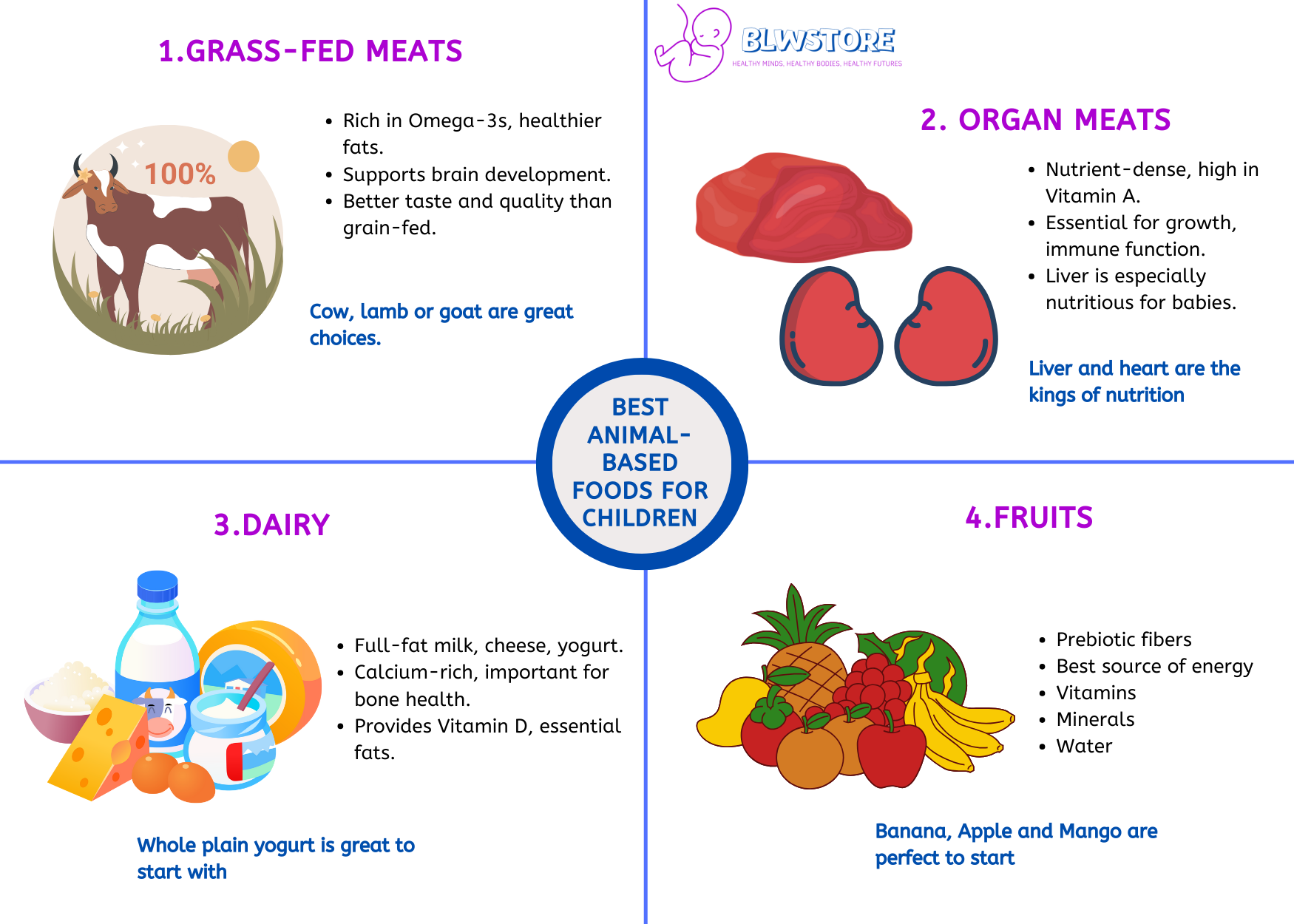
Feeding a child an animal-based diet requires careful planning and thoroughly cooked food.
It’s not about simply providing them with any meat.
Here are some suggestions, organized by 6 to 12 and 12+ months.
For 6-12 Months Old
When you start introducing solids to your child, it’s best to begin with easily digestible and simple foods. Remember that breast milk or formula milk is still the main provider of nutrients, and it will remain this way until your baby is a year old.
Fruits.
We always recommend starting with fruits, as they are sweet and palatable. Babies usually love them, and if they like what you offer them, they will be inclined to try more foods as you introduce more variety. These are the ones we recommend starting with, in order of preference:
Meats and organs.
After introducing 3 or 4 fruits, we recommend offering some ground beef with liver, very well cooked. You can offer a couple of bite-sized pieces each day.
Dairy.
Apart from butter, which you can use to cook, there is no need to include dairy before the 12-month mark. You may offer some of the best yogurts for babies with blended fruit if you want to.
Fish.
We recommend offering salmon, as it is the best fish in terms of nutrition. Fish does not add any important nutrients that meat and organs don’t already provide, so if you want to skip fish altogether, you can.
Eggs.
We recommend offering eggs in the second or third week. There are many ways of introducing them, so we recommend you to read our article on eggs for a complete guide.
Vegetables and Oils
Vegetables and vegetable oils are not needed on an animal-based diet. However, we do recommend adding the following for convenience and to have more variety in the recipes we make. This is our favorite list of vegetables and oils:
- Extra Virgin Olive oil
- Coconut oil
- Coconut
- Sweet Potatoes
- Pumpkins
- Carrots
- Garlic
- Onion
As you can see, no seed oils or leafy greens are needed for complete nutrition.
Grains.
Grains offer nothing of nutritional value to an animal-based diet except fiber, and we’ve got plenty thanks to the fruit. However, cereals are great for adding variety and as a base for many dishes: porridges, sandwiches, cookies, homemade cakes, etc.
The only two grains we recommend offering are:
- Oats
- Spelt
Legumes.
Legumes are okay if offered as part of a more significant recipe. They offer a nutritious source of energy.
We recommend:
- Lentils
- Chickpeas
- Peas
- Kidney/Black Beans
As with grains, offer them as part of different recipes.
For 12+ Months Old
As your little one crosses the one-year milestone, it’s time to gradually refine their diet with a more comprehensive and frequent meal plan.
You’re now entering an exciting phase where you can introduce dairy products in your kid’s diet. This includes nourishing whole cow or goat milk, whole plain yogurt, pasteurized cheeses and honey.
Remember to offer dairy in small quantities. The idea is to include it in your kid’s diet in a balanced way.
Milk.
If you can find goat milk, it’s a better option than cow’s because it’s more nutritious and easier to digest. However, whole cow’s milk is also great.
Yogurt.
We prefer to offer plain whole yogurt. Greek yogurt is also great, as it’s very creamy.
Cheese.
Always choose pasteurized. These are our favorites, but choose your baby’s favorite.
- Riccota
- Mozarella
- Cheddar
- Cottage
Honey.
While honey is a natural sweetener that most toddlers find irresistible, it also offers valuable health benefits.
It’s known for its antioxidant properties. Instead of using artificial sweeteners or table sugar, always use honey.
However, remember that it should be introduced sparingly because of its high sugar content. We recommend one teaspoon every two days if your kid eats fruit regularly and is active.
Last Words
Babies introduced to various animal-based foods before their first birthday are less likely to be picky eaters later in life.
So now you know. You can forget about green vegetables, most grains, and most legumes and focus on high-quality animal-based foods, fresh fruits, and dairy, and you’ll see your kid thrive like never before.
If you have any other questions, do not hesitate to contact us at [email protected]
Happy feeding!
We’re Maria and Alberto, a married couple and educators who are nutrition enthusiasts. Even before we had kids, we were already crazy about nutrition.
We’d read scientific articles, watch videos from nutritionists, and spend hours listening to nutrition podcasts.
Today, we continue doing this, but in a different way, as we’ve learned to sift through the noise and trends. Nutrition, like any other field of knowledge, the more you read and learn, the more you develop a comprehensive understanding of reality, and that’s what has happened to us.
Before having our first child, we focused on learning everything we could about child nutrition, using the same techniques we had already employed, backed by our extensive knowledge in nutrition.
Our mission is to help other parents with their children’s nutrition, to help them become the best versions of themselves.
If we are what we eat and drink, which is absolutely true, let’s do it right!



